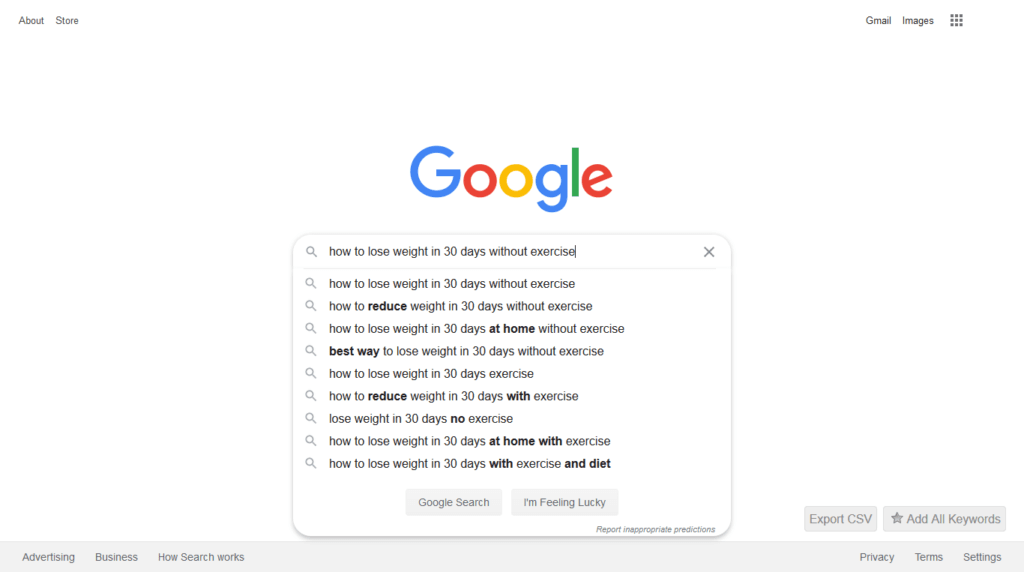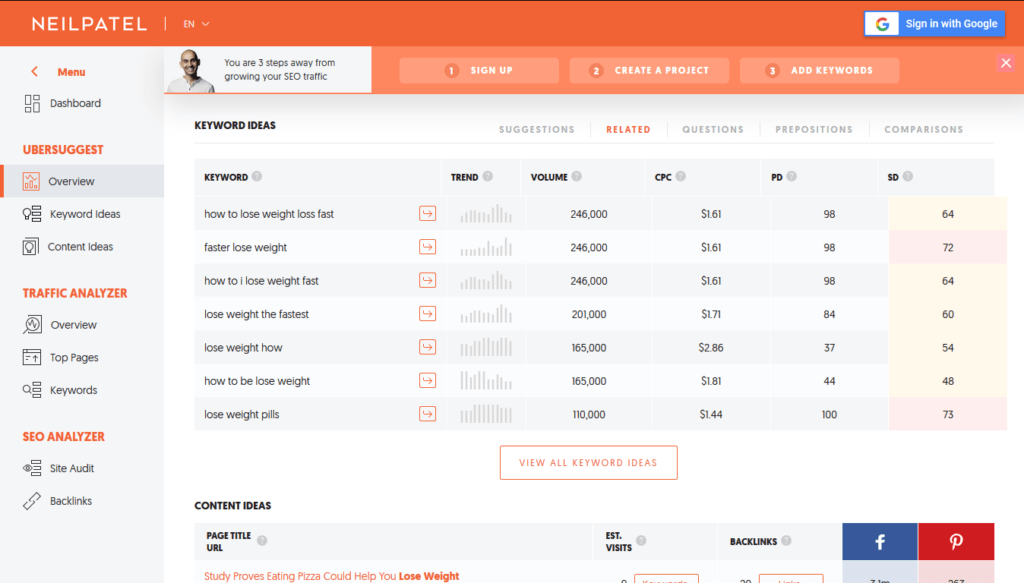An important part of doing good SEO on your blog or YouTube channel is keyword research. This is where you find the best keywords to create content around.
It is important that you do keyword research the right way because there are actually keywords that you’ll be wasting time trying to rank for. The key here is to find keywords that you will be able to rank for.
So, in this article, I’ll take you through the process of doing keyword research step by step so you know exactly what to do to find the best keywords. I’ll also give you a few tips that can help you with your keyword research.
If you’d like ideas for tools, I have an article on the best keyword research tools here.
With that being said, let’s go over how you can start doing keyword research and improving your SEO work. Here are the three steps we’re going to go through:
- Make sure you pick one niche.
- Think of a problem in your niche.
- See if a lot of people have that problem.
- Choose a long-tail keyword.
- Create content that best solves the problem.
And now let’s get started.
Step 1: Make sure you pick one niche.

Before we begin researching keywords, make sure your content has one niche.
A niche is a topic that your content should be focused on. Here are some examples of moneymaking niches: weight loss, personal finance, self-help, technology, etc.
You shouldn’t have multiple niches, especially if they’re too different from each other. If you can create content around one niche, search engines and visitors will have a better idea of what your content is about.
Case in point: this blog, the WebCents Blog, focuses on the “work from home” niche. All my content is about ways you can earn money from your home, whether it be online jobs or starting an online business.
So pick one niche and stick with it.
If you have content that is not related to your chosen niche, it’s probably best to remove them to avoid getting your visitors and search engines confused.
Step 2: Think of a problem in your niche.

The goal of keyword research is to rank for a keyword people are searching for inside your niche. People usually search for keywords because they have problems they would like solved using the Internet.
Let’s use this as an example. If someone’s overweight and they don’t exactly enjoy workouts, they might want to see if they can lose weight in 30 days without exercise. So they would enter the keyword: “how to lose weight in 30 days without exercise.”
This is the kind of thing you need to think about when thinking of problems in your niche so you can find keywords to rank for. Here are four ways you can find potential problems in your niche.
- Imagine you’re new to your niche. What questions would you be asking? One of those questions could be a problem in your niche.
- Think of things people want to do inside your niche and find problems there. Examples: “orange cream milkshake recipe” and “how to fix a wobbly chair.”
- Find blogs or YouTube channels that are inside your niche. Look through their content and figure out what kind of content they are creating to help out their audience.
- Look through forums or Facebook groups and see what problems people are bringing up in threads or group posts.
Once you find a problem inside your niche, it’s time to see if a lot of other people have that same problem and are searching for it on the Internet.
Step 3: See if a lot of people have that problem.
The first step to see if people are searching for the problem is to go to the website where people are searching. I’m talking about Google.
Head over to google.com and type in a keyword that someone with a problem would search for. Google will then give you a dropdown showing you what keywords are being searched for on Google.
For example, typing “how to lose weight in 30 days without exercise” brings up this:

As you can see, the keyword we searched for is at the top of the dropdown list. There are also other keywords related to that exact keyword. This must mean that a whole lot of people have this problem: wanting to lose weight in 30 days without exercising.
Now we can either choose this keyword or choose one of the other keywords listed in the dropdown. Here is something to keep in mind.
If you type a keyword into the Google search bar, the keywords that drop down are keywords that people are searching for on Google.
Again, here’s what you need to do to find out if people are searching a problem:
- Head to Google.com.
- Type in your niche problem in the form of a keyword.
- If you see a dropdown with that keyword and other related keywords, a lot of people must be searching for this problem.
- If you don’t see a dropdown or only 1-3 keywords are in the dropdown, not a lot of people are searching for the problem, so you may want to consider thinking of a different problem.
- Choose what keyword you would like to create a piece of content on.
Step 4: Choose a long-tail keyword.

Once we pick a keyword to create content on, it’s time to see if it’s worth ranking for.
This is a step I did not really think of doing when I first created content. I thought I would automatically rank for any keyword I could think of creating content on.
But you must keep in mind there is competition. Other content creators are trying to rank for the same keyword or for the same problem. The key here is to be very specific with the keyword you choose.
Keep this rule of thumb in mind:
Short, broad keywords like “how to lose weight” have too much competition and are harder to rank for. Long-tail, specific keywords like “how to lose weight in 30 days without exercise” have less competition and are easier to rank for.
So think of the keyword you chose earlier.
If it’s too simple or short, try to make the problem a little more specific. The longer your keyword is, the lesser the chance people are trying to rank for it, and the easier it will be for you to rank.
Make sure your long-tail keyword appears in Google’s dropdown so you know if people are actually searching for it.
Find and Collect Your Keywords
Once you find a keyword you could rank for, open a text file and type it down.
Then repeat steps 2 through 4 of this guide to find some more keywords. Think of some more problems in your niche, see if people are searching for them, and then aim for the long-tail keywords that are less competitive.
As you find long-tail keywords that are worth ranking for, make sure to type them down and save them in that text file so you don’t forget them.
In this next and final step, I’ll show you how you can figure out if you have what it takes to rank for the keyword.
Step 5: Create content that best solves the problem.

Now, before you spend time creating the content and trying to appear for that keyword, ask yourself these questions:
- Do you understand exactly what the problem is?
- Can you provide a fantastic detailed solution to the problem?
- Are you able to explain it clearly and easily? (for example, step by step or for beginners)
- Do you have extra resources for your audience to check out?
If you’ve answered yes to all these questions, you’re ready to create content that solves the problem! If not, keep researching and improving your content until you are ready to go after some keywords.
So, since I’m assuming you’re good to go, let’s start creating content. Here are some things to do as you create your content.
- Pick an attractive title and description that will draw people into your content. Repeat the problem inside your title and description. (Hint: Add power words (“best” or “free) or numbers (5 ways, in 2020, etc.) to your title to grab your readers’ attention.)
- Explain the problem your audience is having and then go through your solution in as much detail as you can. If you’re doing a YouTube video, it might help to write some notes or an entire script.
- Offer a call-to-action to a product that can help your audience even further, or calls-to-action to other free resources they can check out. Link them on your blog or in the description of your YouTube video.
- Review your content to make sure it will serve your audience well in solving their problem. If you need to, make any changes before you publish it to the Internet.
After you publish your content, you can’t expect quick rankings. Make sure you create more content or promote your content on other websites or social media to get the attention of the search engines and receive traffic for your keyword.
You can monitor your YouTube traffic in your YouTube Studio. If you’re blogging, use Google Search Console to track your blog’s search traffic from Google.
Conclusion
So that concludes my five-step formula on how you can do keyword research, whether you want to get more traffic from Google or YouTube.
Some Keyword Research Tools to Use
Now I like to try to make things easy and simple, so I understand if you’d rather rely on a tool or website to help you in your keyword research. Again, keep in mind that most of these tools will require you to pay.
Ubersuggest
But one free keyword research tool you can use is Ubersuggest, which can be found on Neil Patel’s website at neilpatel.com/ubersuggest.

With this site, you can plug in a keyword and actually see the metrics like:
- Volume (how many estimated visits search the keyword per month)
- SEO Difficulty (on a scale of 10, how difficult it is to rank)
- Paid Difficulty and CPC (metrics for paid ads, not for SEO)
Affilorama
Another awesome free tool, and one that I really like, is Affilorama. Affilorama is geared toward affiliate marketers, but inside Affilorama, as a member, you have your own dashboard called AffiloTools where you can get keyword ideas from.
If you’re an aspiring affiliate marketer and are interested in Affilorama, you can check out my Affilorama review before you sign up.
Keywords Everywhere Plugin
And how would you like to see these metrics as you type in the keywords on Google? Well, there’s a tool for that called Keywords Everywhere.
Believe it or not, Keywords Everywhere is really affordable to use. Just download it as a browser plugin for Chrome or Firefox and activate it by following the fairly simple instructions. Then, for just $10, you can search up to 100,000 keywords and the tool can give you the metrics right on your browser! Sound good, right?
Now, if you’d like more ideas for some keyword research tools that you can use, I actually have an article on the best keyword research tools that you can use, both free and paid, so you might want to take a look at that.
Last Words

I hope this article gave you some ideas on how you can do good keyword research, but I especially hope this helped make you feel confident about succeeding and getting some traffic in the world of SEO.
Search engine optimization (SEO) is indeed an intriguing topic, and I have several articles dedicated to it here on WebCents. You might want to check out my simple guide to SEO for beginners for a refresher course on SEO, as well as my tips on how to improve your Google ranking.
With that, my last piece of advice is to just get to work, take action! That’s really the only way you can succeed at ranking on Google or YouTube. Let’s go for it!

